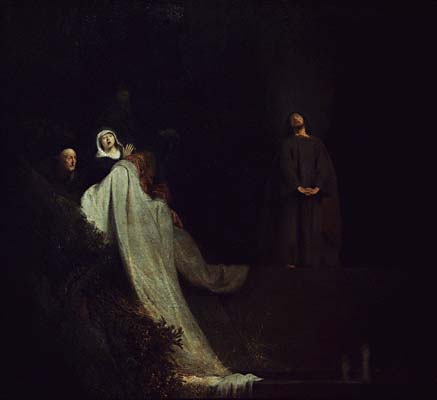JAN LIEVENS SUMMARY |
|
JAN LIEVENS |
| Jan Lievens was born in Leyden
and it was there that he served his first apprenticeship. Later moved to Amsterdam where
he became a pupil of Pieter Lastman and it was there that he became very close friends
with Rembrandt. He was a precocious youth and quickly became known as a master painter and
etcher. Lievens shared the painting studio with the slightly older Rembrandt between 1625 and 1631. The two artists often collaborated on the same picture: the Portrait of a Child (Rijksmuseum, Amsterdam) is signed "Lievens retouched by Rembrandt". Rembrandt also painted the image of his close friend Lievens into several of his paintings, most notably Young Christ in the Temple. The early works of both painters exhibit similar attention to details, Caravagesque dark tones, and dramatic mood. For example, the very theatrical Lievens work titled The Raising of Lazarus, dated 1631 and presently located in the Art Gallery and Museum, Brighton. The attribution of paintings from their joint studio period has often presented a problem to scholars, and there were many false attributions to Rembrandt of works that were actually painted by Lievens. The Secretary of Prince Frederick Henry, Constantin Huygens, was a patron of both Rembrandt and Lievens. Huygens regarded both artists as equals during this 6 year period of time. However, Huygens considered Rembrandt to be more emotionally expressive and Lievens superior in inventivness and boldness. Lievens tended to paint on a larger scale than Rembrandt, often his works are life size. His early pictures are genre scenes, religious subjects, and portraits. Lievens travelled to England in 1632 and stayed for two years, During this time he was reputed to have painted the Royal Family, however this painting is unknown today. In 1634 Lievens returned to Amsterdam and his style was greatly changed. His portraits were now strongly influenced by the courtly style of Sir Anthony van Dyck. His landscapes show his study of both Rubens and Brouwer. Until his death, Lievens lived primarily in Amsterdam, where he was a very popular portraitist and successful painter of large-scale historical and allegorical subjects (for example, his paintings from 1656 and 1661 for the new Amsterdam Town Hall.) |
